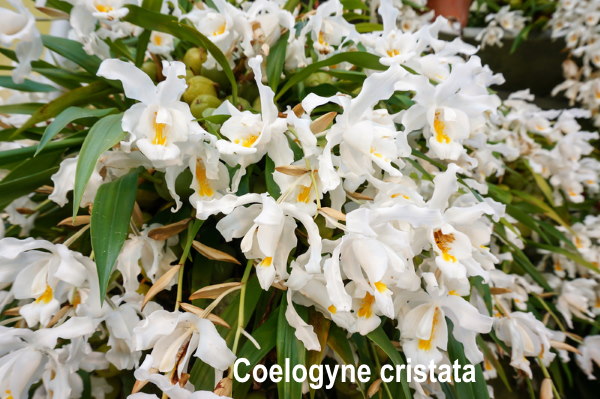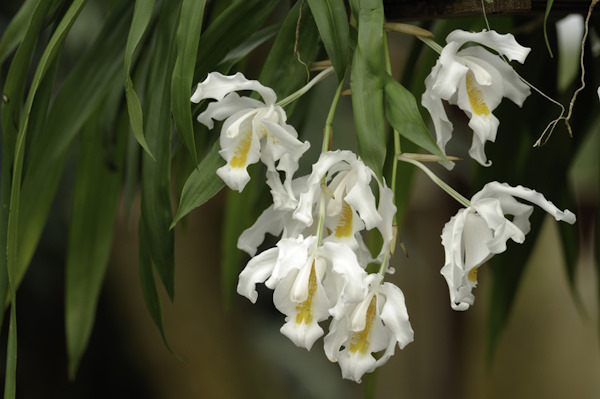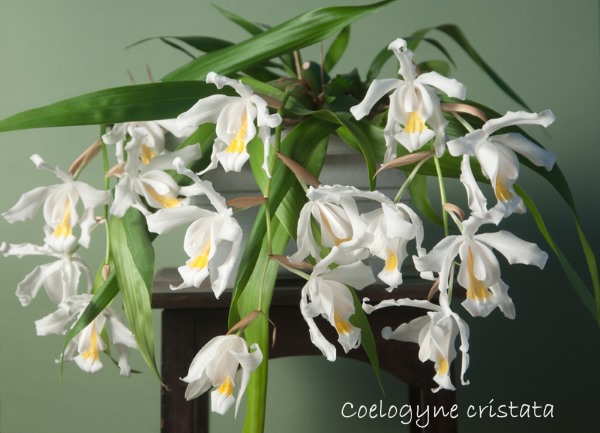Coelogyne Cristata Orchid Care
An abundance of pristine white fragrant flowers make Coelogyne cristata a gorgeous orchid that's irresistible. In this guide, you'll get indoor orchid care tips and find out what makes Coelogynes bloom.

Get to Know Coelogyne Cristata
Coelogyne (pronounced See-loj'in-ee) is epiphytic in the wild, growing on tree branches where it anchors itself with its roots. Epiphyte comes from the Greek words epi meaning upon and phyton meaning plant.
All orchids in the Coelogyne genus are epiphytic and have fat, egg-shaped pseudobulbs, each with 2 long, narrow arching leaves emerging from the top.
How big does it get? It will reach a height of about 12 in (30 cm).
C. cristata flower spikes can grow up to 1 ft (30 cm) long, each branched spike carrying several long-lasting flowers 3-4 inches (8-10 cm) wide.
And those pristine white flowers are stunning, with golden-yellow fuzzy markings on the lip and ruffled petals. They're also intoxicatingly fragrant.
With a cool winter rest (see below), you can expect an abundance of blooms in winter and early spring.
Coelogyne cristata likes free-flowing air as in its native high-mountain Himalayan habitat of India and Asia. Put your orchid where it'll enjoy plenty of air circulation. Fans are fine, but keep it away from heat or AC vents.
 Photo credit istockphoto.com
Photo credit istockphoto.comGrowing Coelogyne Cristata Year-Round
To repot...or not. Fir bark medium breaks down after a couple years and needs replaced. The best time to repot your orchid is when new growth begins, after the winter rest. Carefully tease out the old potting medium with your fingers, taking care not to damage its fine roots.
Winter care. Coelogyne cristata needs a cool winter rest for 6 weeks to encourage flower buds. Give your orchid cooler temperatures (45-55°F/7-13°C) and water sparingly. You can expect the pseudobulbs to shrivel during this winter rest; it's normal. Stop fertilizing. When you see new growth, resume normal care.
Brown leaf tips can be caused by dry soil, dry air or tap water that contains fluoride, chlorine and salts that accumulate in the potting medium. This build up of soluble salts come from the chemicals in tap water and fertilizers. Use distilled or rainwater and increase humidity if the air is too dry.
Sticky leaves are normal for this genus. New unfurling leaves are often covered with a sticky sap. It's a good idea to wash off the sap at some point because it can bind the flower stems that emerge. Take it to the sink to rinse them off, using tepid water.
Take a Stand
Raise your Coelogyne cristata up on a pedestal plant stand as soon as you see the first buds appear. You want to show off those gorgeous pendulous flowers, don't you?
Although Coelogynes are not the easiest orchids to grow indoors, the sheer number of white-and-gold blooms make the prospect of cultivating them quite tempting.
You'll find Coelogyne cristata orchids for sale in the winter and spring, when most are in bloom.
 Give your orchid a boost on a stand for all to admire. Photo © Alexander Kurlovich
Give your orchid a boost on a stand for all to admire. Photo © Alexander KurlovichCoelogyne Cristata Varieties
- Coelogyne cristata var. alba is an all-white variety of the species
- C.r. 'Glacier Mint' is a popular cultivar that blooms profusely in early spring
Trying to identify your Coelogyne cristata variety? Take a look at this page on Coelogyne Culture from American Orchid Society for more cultivars with pictures.
Coelogyne Orchid Care Tips
Light: Bright indirect light year-round. Put your orchid where it'll get plenty of light, but out of direct sun. If you don't have a spot near a window, grow lights work beautifully. Use 1 warm white tube and 1 cool white tube under a reflector. Place orchids about 8 inches (20 cm) beneath the light for 14-16 hours a day. It's also important to give them darkness at night. Orchids need a rest, too. You can make it easy on yourself by using a timer so the lights will come on at the same time each day.
Water: Water from the bottom to avoid getting pseudobulbs and leaves wet. Stand pot in tepid water for 30 minutes. Aim to keep the soil moist during the growing season. During the winter rest, water just enough to prevent the medium from drying out completely. Coelogynes have water-storing pseudobulbs, making them more tolerant of dry soil than wet.
Humidity: Preferably 60-70% relative humidity. If it drops below 60%, use a humidity tray or cool-mist room humidifier. Grouping plants also helps to maintain the moisture in the air around them.
Temperature: 60-65°F/16-18°C nights and 70-75°F/21-24°C days; requires a cool rest period to flower (see above).
Soil: Fine- or medium-grade fir bark
Fertilizer: Feed every 2 weeks while plant is actively growing and flowering. I recommend an organic orchid fertilizer because it won't burn roots. Don't fertilize during the winter rest period.
Propagation: Division. The best time to divide is when you see a flush of new growth. Keep at least 6 pseudobulbs in a clump and pot it separately in orchid potting mix.


